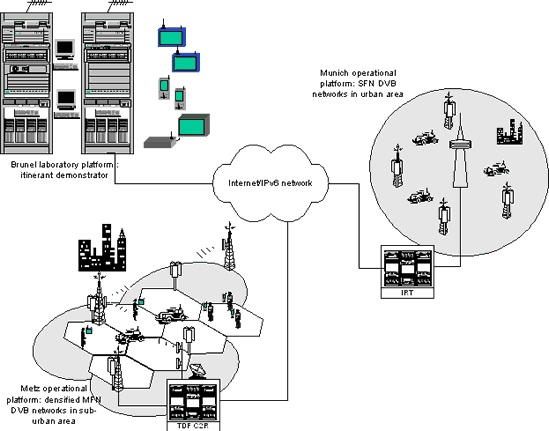Work Package 8
Integration, Demonstrations and
Field Trials
INSTINCT intends to enable
the commercial exploitation of 2G/3G and DTT co-operation and should
therefore provide decision makers with tangible evidence of its pros
and cons. To do so, proofs of concept are implemented. In the process
of dissemination resulting in the adoption of innovative concepts, live
demonstrations are indeed a key factor for success. Test platforms also
enable necessary field tests so as to verify the technical feasibility
of the system and validate the services and technology on panels of
real users.
To show how the project can contribute to these objectives, an activity
within INSTINCT devoted to integration, field trials, scenario development
and demonstrations, implements a limited number of service scenarios
that could later be made available to the end user in operational systems
and validates the services on test platforms.
Platforms will be set up in three countries virtually covering 50% of
EC consumers: France, Germany and the United Kingdom. This allows a
system to be demonstrated to investors in their own language and to
benefit from a variety of 3G and DTT history contexts. It is also an
opportunity to have feedback from a panel of users with different habits.
Besides, an additional platform is set up in Brazil to take into account
all aspects specific to the south-American market.
In the first phase of the project, platforms integrate and test the
necessary components enabling the elementary commercial exploitation
of standard DTT/3G co-operation systems: scalable service provisioning
and management, mobility management, consistent resource and network
management, low power DVB-T/DVB-H receivers, etc… In this phase,
the demonstration activities will be limited, because most of the effort
will be devoted to the set-up of demonstrators. Targeted terminals are
distributed for this phase. Depending on the usage, these terminals
may make use of mobile DVB-T or DVB-H.

Figure: INSTINCT European test beds
interconnection in phase 1 of the project
Network aspects, RF spectrum
engineering and system scalability are evaluated. Regarding network
aspects, the use of IPv6, first in the core network then in the access
network, will allow issues to be dealt with such as seamless hand-over,
billing or security. For this work, INSTINCT reuses as much as possible
the results of 5th framework and 6th framework projects that have already
tackled IPv6 issues. In the area of RF spectrum engineering, the novel
concept – inspired from the telco world- of tri-sectorised, small
size cells for DVB networks are evaluated on sample sites, where 3G
and low power DVB equipment coexist.
Management in the broadest sense of the word is evaluated: QoS management
with new tools developed in INSTINCT, management of inter-working networks,
and user management. Validating these tools is necessary to verify that
network and service operators will be provided with solutions that ensure
secure exploitation of the system. The interconnection between the three
platforms via the Internet will simulate the distribution of operators:
content providers, mediation operators, etc. and evaluate the performance
of the overall system, when used in on a real scale.
Because it is considered a major driver for the business cases, a comprehensive
validation of the end user expectations are sought so that feedback
on both the service usage and the technology is gathered. The results
of these tests enable to conclude on eco-system and network dimensioning
aspects such as refinement of user interfaces, identification of bottlenecks
for the user and in the end, definition of pricing policies.
The second phase will lay the bases for the exploitation of higher bit
rate services thanks to micro-cellular DVB cells - using the appropriate
standard to reach mobile users – and will refine all other content
production and management tools, terminal and network aspects so as
to provide all actors in the value chain with the most appropriate solutions.
The second phase will also comprise the demonstration and training activities
necessary to enable the take off of the concept. In the long run, the
objective is also to open platforms to third parties to enable them
to develop and validate their own applications.
The technical approach is articulated along five activities:
- Scenario implementation, RBB
will lead this activity.
- Laboratory and platform integration,
TDF will lead this activity.
- Field trials, IRT
will lead this activity.
- Consumer validations, UoC
will lead this activity.
- Demonstrations, DTAG will lead this
activity.
TDF will coordinate these
activities in phase 1.